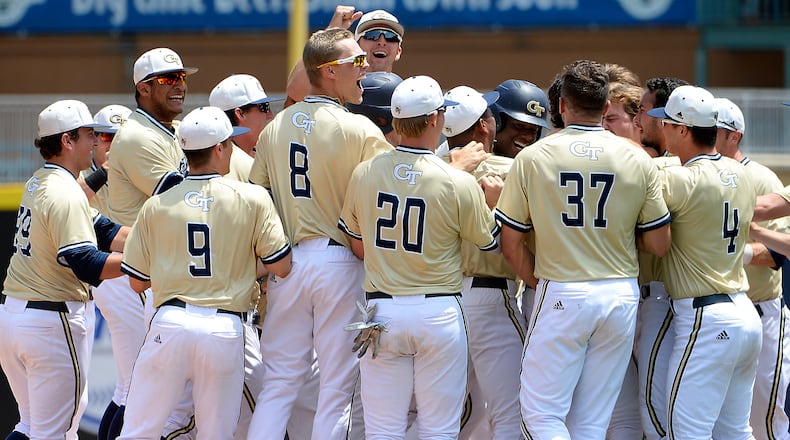The reasons for Georgia Tech’s ascension from back-to-back seasons without NCAA tournament berths to the No. 3 seed in the entire 64-team field are many. Perhaps the most frequently cited are the hires of assistant coach James Ramsey and volunteer assistant coach Dan Jaffe and the leadership provided by the Yellow Jackets’ senior class, both of which have inspired a gritty approach.
The increased depth of the pitching staff and the development of players such as center fielder Nick Wilhite (whose batting average jumped from .155 last season to .320 this season) are two other factors as has Tech improved from 31-27 in 2018 to 41-17 this season. When the Jackets open regional play Friday night against Florida A&M at Russ Chandler Stadium, they’ll also have another asset that they’ve counted on this season – their increased reliance on analytics.
Coach Danny Hall and his staff rely on two data services, TrackMan and Synergy Sports Technology. Hall said that “we look at them every day, and so we depend on that a lot.”
Tech had previously utilized Synergy, which provides data accumulated pitch by pitch from thousands of Division I games, capturing pitch types, velocity, swing types and more. This is the first season that Tech has used TrackMan, which uses 3D Doppler radar to record data such as pitch velocity, spin rate, extension (the distance from the pitching rubber that a pitcher releases the ball) and horizontal and vertical break on pitches, as well as exit speed (speed of the ball coming off the bat) and the angle at which batted balls travel after contact.
“And it may be as simple as, against breaking balls, this guy’s hitting .180. Against fastballs, he’s hitting .350,” Hall said. “If you’ve got a guy that can throw a breaking ball and throw it for a strike, you’ll probably lean on that pitch.”
While some of the information was available previously, players have said that scouting reports this season have added detail.
“In the past, it’s kind of like, this dude throws 88 to 90,” shortstop Luke Waddell said.
In hitters meetings, Ramsey furnishes the Jackets with probabilities on what pitches they’ll likely face from a particular pitcher based on the count. (The coaching staff also has been aided by a team of data-mining student managers, one of whom is interning at TrackMan this summer.)
Batters can know now the release points and spin rates on a pitcher’s assortment of pitches – typically, the faster the spin rate, the more difficult it is to hit. Ramsey also supplies batters with what they call “count trees,” which lay out which pitches a pitcher has thrown at each count.
Designated hitter Michael Guldberg, who ranks second in the ACC in batting average at .366, devours the count-tree data, studying what percentage of the time a pitcher has thrown fastballs, curves or change-ups when the count is 0-1 with runners in scoring position, for instance. He recalled an opposing pitcher who relied heavily on change-ups when the count was 1-1, and then saw that pitch at each 1-1 count he faced against him that game.
“It’s a lot of help,” Guldberg said. “I’m an (industrial engineering) major and a (computer science) minor, so it’s kind of right up my alley.”
The data is sliced so deeply that it can reveal how a pitcher’s tendencies change depending on how many times he has gone through the batting order. While it’s a lot to commit to memory, the charts are kept in the dugout for a quick review before an at-bat.
“So I really do like looking at that and just having a better idea of what I’m going to be seeing through each at-bat,” third baseman Jackson Webb said.
Tech coaches also use the spray charts provided by Synergy to align the defensive in aggressive shifts. Deploying three infielders to the first-base side of second base against a left-handed pull hitter is not uncommon, as the college game catches up to that data-driven approach of major-league baseball.
The TrackMan data also provides coaches with better insight into their own players. After first baseman Tristin English went 0-for-12 in a three-game series against UCLA early in the season, coaches were able to show him that he didn’t need to fix anything. He was, in fact, leading the team in exit velocity, meaning he was hitting the ball as hard as anyone on the team. English’s being named to the All-ACC first team for the third time suggested that TrackMan was more prescient than the box scores.
Tech’s pursuit of its first College World Series berth since 2006 won’t rely solely on TrackMan and Synergy. But it won’t hurt.
“It’s all just more and more information to use,” Waddell said. “Some people use some and other people use others, but definitely it’s helping the hitters and the pitchers both.”
About the Author
Keep Reading
The Latest
Featured


